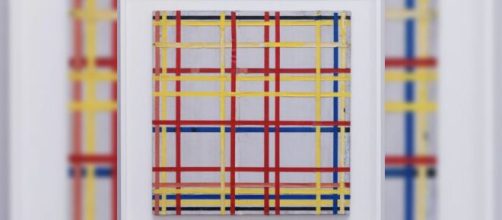The way this art news was reported, you’d think it was a big deal and unheard of.
The abstract painting “New York City” by Piet Mondrian, hanging in the Museum of Modern Art in New York for the last 75 years, was hung upside down. My first thought was, “So what”?
Which end is up?
No one noticed until last week, when art historian Susanne Meyer-Büser spotted the error. She said she knew from a photograph of the painting on an easel in Mondrian’s studio.
Mondrian would probably wonder what all the fuss was about. From his papers archived at Yale University, it’s clear that the only way it matters how paintings hang is if you try to find reality in his vertical and horizontal lines.
And he did want you to.
Even though Mondrian wrote at length that one should make as little use as possible of reality in art, Meyer-Büser told The Guardian that “the thickening of the grid (at the bottom) of ‘New York City should be at the top, like a sky.”
Mondrian wouldn’t have liked that sky reference. You’d think a historian would be more familiar with his writings. Moreover, since the painter made such a point about avoiding reality in his work, it seems incongruous to even pay attention to what is up and what is down when hanging the work.
Not that Mondrian is completely innocent here. Considering that he wanted nothing to do with reality, why give the painting the real-world title “New York City”?
Another abstract painter also had his work hung the wrong way and lived to see it. Mark Rothko expressed outrage that his image of large, blurry-edged rectangles drifting in mid-air was displayed horizontally instead of vertically.
If you ask me, his rectangles drift better when viewed vertically. Horizontally, they nestle too comfortably when seen one on top of the other. But never mind that.
How can an image signifying nothing in the seeable world hang in the wrong position? Given that it is non-objective, and given that a well-composed image will hold up no matter the viewing angle, where’s the beef?
Yet, “The Legacy of Mark Rothko” by Lee Seldes reveals the painter’s disappointment over the hanging of one of his pictures on exhibit in a Colorado school where he was teaching:
“One of them I found was hung horizontally,” he said.
“I phoned the hanger about his error. ‘Oh, it was no error,’ he said. ‘I thought it filled the space better.’”
Can the “hanger” of a Rothko painting with zero connection to objective reality be faulted for hanging the work horizontally instead of vertically? Can artists dictate how their work should be displayed in the actual world if their work avoids the actual world?
Up close and personal
Rothko went so far as to provide instructions on how viewers should look at his work. For example, he asked that his pictures hang low on a wall so people could stand face-to-face with it
He also requested that viewers stand not farther than 18 inches away for the sake of immediacy and for better immersion into the work, he said.
Rothko wanted his viewers to get close to his work to such a degree that he even wanted each picture to hang in a room of its own. He also asked that no more than one or two people enter the room at a time.
For a painter who separates his imagery from anything existent to be so concerned with installation in an existing space argues against his work, don’t you think?


